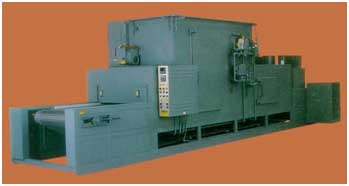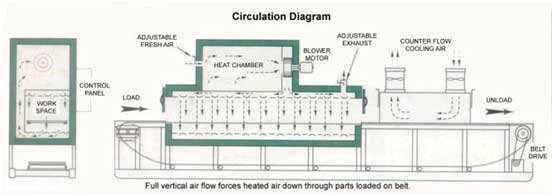CONVEYOR OVEN
APPLICATION
Conveyor oven used in vegetable dehydration have multiple belts in line, and the feed is transferred from one belt to another.
PROCESS
Multiple heat zones
Extended loading and unloading zones
Special belt construction or attachments
Cooling zone to reduce part temperature
Our experienced engineers will work closely with you to develop a conveyor oven to meet your particular requirements. Every unit is completely assembled and tested. You are invited to witness test and run sample parts at our factory prior to shipment.

STANDARD FEATURES
- Aluminized or stainless steel interior depending on maximum temperature rating.
- 16 gauge aluminized steel exterior with enamel finish
- Welded structural steel, channel base provides a rigid assembly easily moved at any time.
- Heavy duty, all welded, structural steel slide bed is supported by cross angles welded to vertical structural members to transfer load to base
- Belt slide bed herringbone construction provides for even belt wear.
- Side hinged doors provided along oven length for access to work space and heat chamber.
- Heavy duty variable speed belt drive with torque limiting device
- Belt tracked and guided as necessary with rollers to prevent wandering and potential belt damage
- Adjustable dampers at each end of heat zone can be positioned near load to minimize heat loss from end of oven.
- Adjustable patented opposed louvers on full coverage supply and return ductwork.
- Duct work removable for cleaning
- Brushed stainless steel control panel face
SIZING OF CONVEYOR OVEN LENGTH
To determine if a belt conveyor oven is practical for your application, estimate the heated tunnel length. Belt conveyor equipment is sized to the application based on part dimensions, production rate and dwell time.
Belt width is selected to accommodate the desired loading pattern, such as in line, side by side or four abreast. The loading density, parts per lineal foot, and production rate determine the design belt speed. The design heat zone length is the product of belt speed and dwell time.
It is important to understand the relationship between belt width, production rate and heat zone length. Doubling the belt width will double the production rate, or allow the heat zone to be half as long.

To estimate the length of belt conveyor equipment required for your application, insert your process information in the relationships below. To the heat zone length calculated, the length of load zone and unload zone must be added. Approximately 2 additional feet of length will be required for belt guarding and drive.
Equipment width will be approximately 3 feet wider than belt width to accommodate insulation, duct work and control enclosure.
To receive a detailed quotation for your application complete the “Request for Quotation Data Sheet” found on the reverse side of our catalogue index.
(Production rate of …………parts per hour) = (Belt speed of ………. feet per hour)
(Loading density of ……….parts per lineal foot)
(Belt speed of ….. feet per hour) X (Dwell time of ….. hour) = (Heat zone length of ………. feet)

STANDARD EQUIPMENT
ALL MODELS
230 volts, 3-phase, 50Hz
Other electrical characteristics available
Vertical downward air flow between full coverage ductwork above and below conveyor belt. Other airflow patterns available. Trilite Green enamel painted aluminized steel exterior.
ELECTRIC MODELS
each features completely wired, side access control panel enclosing terminals for incoming power, temperature controllers, push buttons and pilot lights. Motor starter and heating element contactors electrically interlocked to shut off heaters if power to blower is interrupted and to permit operation of blower without heat for cooling. In coloy sheathed tubular heating elements.
GAS MODELS
– 1,000 BTU natural gas at 6″ water column pressure;
– Other gas characteristics available
Control panel as on electric models. Automatic preignition purge period and push button electric ignition contributes to ease of operation. Modulating gas burner is protected with electronic flame safety relay.
ADDITIONAL EQUIPMENT AVAILABLE
Exhaust Hood: with or without tube axial fan, to exhaust heat and fumes escaping open ends of heat zone………………EXH
Cooling Zone: installed over extended unload conveyor, with forced convection cooling………………………………………….CZ
Multiple Heat Zones: to provide temperature profile during processing, specify quantity and length of each zone.MHZ
SCR Belt Speed Control: in lieu of mechanical 1:2.5 ratio, provides 1:20 turn down ration………………………………………..SBS
Belt speed Indicator: used with SCR variable speed belt control………………………………………………………………………………..BSI
